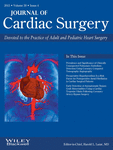Early Detection of Asymptomatic Bypass Graft Abnormalities Using a Cardiac Troponin I Ratio Following Coronary Artery Bypass Surgery
Abstract
Background
We sought to identify the best cardiac Troponin I (cTnI) ratio to detect asymptomatic graft or anastomoses anomalies after myocardial revascularization.
Methods
Patients with a rising cTnI profile, based on measurements at 6 and 12 hours (cTnI 12 hours : 6 hours ratio >1) after the last anastomosis in off-pump surgery or after cardiopulmonary bypass in on-pump surgery, underwent a coronary angiogram, despite an uncomplicated postoperative course and absence of electrocardiogram changes. The optimal threshold value for the ratio was determined using a receiving operator characteristic (ROC) curve.
Results
From April 2005 to May 2011, among 1693 patients undergoing isolated coronary artery bypass graft (CABG), 29 (1.7%) had a cTnI ratio >1 and underwent postoperative angiography. Twenty abnormalities were observed in 16 patients (55%). In the anastomoses, there were four occlusions and four stenosis. In the grafts, there were 12 stenosis: two of the Y graft anastomosis, two dissections, five hematomas and three kinking. TIMI flow grade based on results of the Thrombolysis In Myocardial Infarction trial was 3 in six patients, 1 in five, and 0 in five. In the 16 patients with lesions, the cTnI ratio was 2.1 ± 1.4 versus 1.4 ± 0.3 in patients with no lesions (p = 0.09). A ratio of 1.3 (p = 0.003) was determined by ROC curve analysis as having the greatest discriminant capacity, with associated sensitivity of 87.5% and specificity of 62%.
Conclusion
A cTnI 12 hours : 6 hours ratio >1.3 may be indicative of these abnormalities. Early identification of these anomalies may avoid adverse outcomes. doi: 10.1111/jocs.12517 (J Card Surg 2015;30:319–323)




